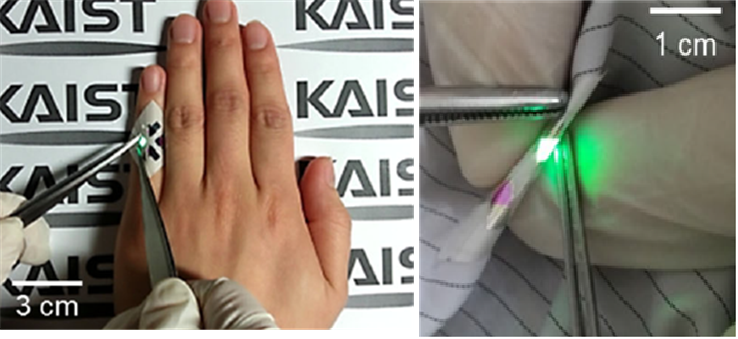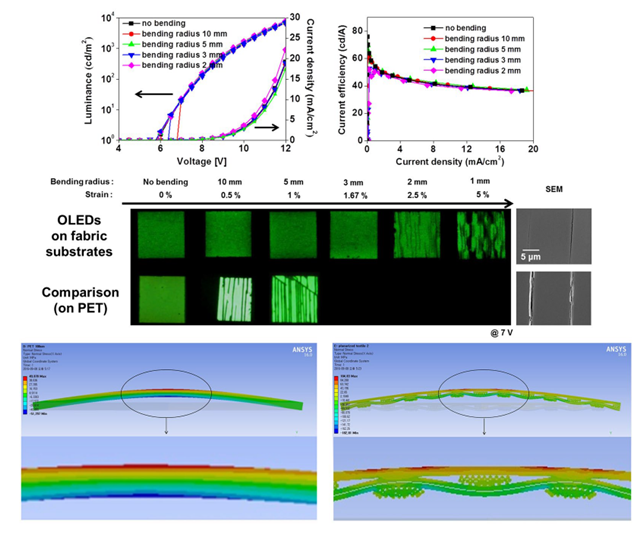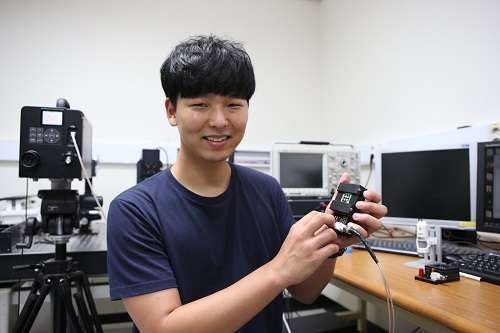Researchers develop highly flexible, wearable display

How do you feel when technology you saw in a movie is made into reality? Collaboration between the electrical engineering and the textile industries has made video screens and displays on clothing a reality.
A research team led by Professor Kyung Cheol Choi at the School of Electrical Engineering presented wearable displays for applications including fashion, IT and healthcare. Integrating organic light-emitting diodes (OLEDs) into fabrics, the team developed the most highly flexible and reliable technology for wearable displays in the world.
As world trends are focusing on the Internet of Things (IoT) and wearable technology, the team drew a lot of attention by developing and commercializing clothing-integrated wearable displays. The research for realizing displays on clothing gained considerable attention from academia as well as industry when research on luminescence in fabrics was introduced in 2011; however, there was no technology for commercializing it due to its surface roughness and flexibility.
Because of this technical limitation, clothing-integrated wearable displays were thought to be unreachable technology. However, the KAIST team recently succeeded in developing the world's most highly efficient, light-emitting clothes that can be commercialized.

The research team used two different approaches, fabric type and fiber type, in order to realize clothing-integrated wearable displays. In 2015, the team successfully laminated a thin planarization sheet thermally onto fabric to form a surface that is compatible with OLEDs approximately 200 nanometers thick. Also, the team reported their research outcomes on enhancing the reliability of operating fiber-based OLEDs. In 2016, the team introduced a dip-coating method capable of uniformly depositing layers of polymer light-emitting diodes, which show high luminance even on thin fabric.
Based on the research performance in 2015 and 2016, Ph.D. candidate Seungyeop Choi led the research team in an effort that realized fabric-based OLEDs with high luminance and efficiency while maintaining the flexibility of the fabric.
The long-term reliability of this wearable device was verified through the team's organic and inorganic encapsulation technology. According to the team, their wearable device facilitates the operation of OLEDs even at a bending radius of 2mm. Choi says, "Having wavy structures and empty spaces, fiber plays a significant role in lowering the mechanical stress on the OLEDs."

He adds, "Screen displayed on our daily clothing is no longer a future technology. Light-emitting clothes will have considerable influence on not only the e-textile industry but also the automobile and healthcare industries. It means a lot to realize clothing-integrated OLEDs that have the world's best luminance and efficiency. It is the most flexible fabric-based light-emitting device among those reported."
The research report was published in Scientific Reports in July.
More information: Seungyeop Choi et al, Highly Flexible and Efficient Fabric-Based Organic Light-Emitting Devices for Clothing-Shaped Wearable Displays, Scientific Reports (2017). DOI: 10.1038/s41598-017-06733-8
Journal information: Scientific Reports




















